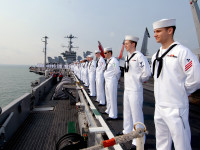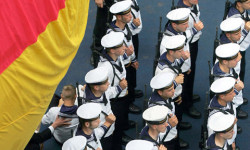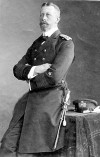The United States Navy (USN, also shortening US Navy) is the United States Navy, thus becoming a combined force of the United States Armed Forces and one of the seven Uniformed Services of the United States. With 323,225 active soldiers and 109,866 reservists, it is the world's largest and most powerful navy in August 2013, comprising 285 ships and over 3,700 aircraft and helicopters.
Crews
- Seaman Recruit (no badge)
- Seaman Apprentice
- Seaman
Seaman Apprentice (1), Seaman (2)
Petty Officers and Chief Petty Officers
- Petty Officer Third Class
- Petty Officer Second Class
- Petty Officer First Class
- Chief Petty Officer
- Senior Chief Petty Officer
- Master Chief Petty Officer
- Command Master Chief Petty Officer
- Fleet/Force Master Chief Petty Officer
- Master Chief Petty Officer of the Navy
Petty Officer Third Class (3), Petty Officer Second Class (4), Petty Officer First Class (5), Chief Petty Officer (6), Senior Chief Petty Officer (7), Master Chief Petty Officer (8), Command Master Chief Petty Officer (9), Fleet/Force Master Chief Petty Officer (10), Master Chief Petty Officer of the Navy (11)
The NCOs of the US Navy have different usage names that correspond to their specialization and also reflect in their rank. For example, a Petty Officer First Class using a Gunner's Mate is correctly named Gunner's Mate First Class.
In addition, Navy sergeants wear Service Stripes on the left sleeve of their A-Class uniform (not on their daily service uniform). Each of these red bars represents 4 years of service. There is also a golden version worn by NCOs who have served for at least 12 years without disciplinary action.
The rank / position of Master Chief Petty Officer of the Navy is singular in the Navy. He works in an advisory role for the Chief of Naval Operations and the Chief of Naval Personnel, and teaches him on matters that affect the crews in particular.
Warrant Officers
- Chief Warrant Officer 2
- Chief Warrant Officer 3
- Chief Warrant Officer 4
- Chief Warrant Officer 5
Chief Warrant Officer 2 (12), Chief Warrant Officer 3 (13), Chief Warrant Officer 4 (14), Chief Warrant Officer 5 (15)
The Navy, like the US Army and the US Marine Corps, also has Warrant Officers in their ranks. These soldiers are most likely to be compared to officers of the military service in the Bundeswehr (german army). They are specialists in their field with similar powers as a regular officer, but only in their professional use.
Officers
- Ensign
- Lieutenant Junior Grade
- Lieutenant
- Lieutenant Commander
- Commander
- Captain
Ensign (16), Lieutenant Junior Grade (17), Lieutenant (18), Lieutenant Commander (19), Commander (20), Captain (21)
The officer corps of the Navy is divided into two groups, the Line Officers and the Staff Officers, with the Line Officers in turn divided into the following two groups:
- Unrestricted line: (troop officers capable of commanding at sea or ashore): overwater warfare, flying personnel, underwater warfare, special warfare, nuclear
- Restricted line: engineers, aircraft engineers, aircraft repair, encryption technicians, naval intelligence, public relations, meteorology and oceanography
- Staff officers: Supply Corps, Medical Corps, Hospital Corps, Dental Corps, Nurses Corps, Spiritual Corps, Civil Pioneer Corps, Judge Advocate General's Corps, Navy Band Corps
Admiral
- Rear Admiral (lh)2
- Rear Admiral (uh)2
- Vice Admiral
- Admiral
- Fleet Admiral
Rear Admiral (lh)2 (22), Rear Admiral (uh)2 (23), Vice Admiral (24), Admiral (25), Fleet Admiral (26)
The rank of Fleet Admiral is awarded only in wartime with the approval of the US Congress.
The rank of Rear Admiral is divided into two levels (lower half and upper half). Today, these ranks are each Admiralsränge. In the 19th century, however, today's Rear Admiral (lh), so a 1-star admiral, Commodore was called and was not a flag officer, but a captain with extended responsibilities.
You can find the right literature here:
The Naval Institute Historical Atlas of the U.S. Navy
From the Battle of Flamborough Head during the American Revolution to the naval air wars over Vietnam and Kuwait, this historical atlas charts the course of the U.S. Navy across its entire history. Laid out here are the frigate duels of the War of 1812, the confrontation of ironclads during the Civil War, the World War II carrier battles in the Pacific, and the amphibious landings in Korea. Depicted also are campaigns, operations, and interwar interventions--like the cruise of the Susquehanna, Perry's mission to Japan, the Cuban Missile Crisis, and Desert Storm--all helping to make this cartographic portrait of U.S. naval actions understandable at a glance. The maps in this large-format, high quality book are presented in full color and show the deployment of ships, their tracks, and even some shore activity. Each map has facing text that describes the action and its political, economic, and strategic significance. The atlas is organized chronologically into ten eras with each section preceded by a thoughtful essay about that historical period and accompanied by relevant illustrations of ships, battles, and portraits of significant individuals. Winner of the 1996 John Lyman Book Award, this handy and attractive reference will be treasured by everyone who enjoys reading American maritime history. Students, scholars, and old salts alike will appreciate the bird's eye view of how the Navy's fortunes have changed over the years, successfully guarding the nation and securing its interests.
Complete Guide to United States Navy Medals, Badges and Insignia: World War II to Present

Complete Guide to United States Navy Medals, Badges and Insignia: World War II to Present Revised edition Edition
This is the only book in the world covering all U.S. Navy awards. Compiled by James G. Thompson, Complete Guide To United States Navy Medals, Badges And Insignia World War II To Present is a detailed catalogue of Navy medals and ribbons, commonly awarded foreign and UN medals, all Navy insignia from World War II to the present, enlisted specialty marks and much more. Black-and-white and color diagrams or photographs of each medal, badge, ribbon, insignia and ratings make this a first-rate, no-error guide for identification and recognition. With a Complete order of precedence in colour for all Navy awards it also includes details on wear, display and claiming of U.S. Military medals, with all ratings and rank described. An outstanding reference, Complete Guide To United States Navy Medals, Badges And Insignia World War II To Present is a core addition to military history reference and resource collections. About the Author James G. Thompson is a leading military collector and historian, specializing in American armed forces.
Aircraft Carriers of the United States Navy (Images of War)
In 1922 the US Navy commissioned its first small experimental aircraft carrier. This was followed into service by two much larger and capable carriers in 1927 with five more being built prior to the Japanese attack on Pearl Harbor including three large Yorktown class.
To take the offensive against the Japanese Navy, the American Congress funded by far the largest carrier building program in history based on the Essex class, a larger version of the pre-war Yorktown vessels. Of the twenty-six ordered, fourteen were commissioned in time to see Second World War service. These were joined by many smaller classes of carriers, including light carriers and escort carriers.
Post-war ever larger and more capable carriers were commissioned. Since 1975, when the first of a fleet of ten nuclear-powered Nimitz class carriers was commissioned, they have epitomized United States superpower status and worldwide power projection. These are due to be replaced in the decades to come with the even more sophisticated nuclear-powered Gerald R. Ford class.
Compiled and written by Michael Green, Aircraft Carriers of the United States Navy contains superb images of all the different types of classes of carriers employed by the US Navy since 1922. These and its highly informative text and captions give the reader a broad overview of this fascinating subject.
The U.S. Navy SEAL Survival Handbook: Learn the Survival Techniques and Strategies of America's Elite Warriors (US Army Survival)

The U.S. Navy SEAL Survival Handbook: Learn the Survival Techniques and Strategies of America's Elite Warriors (US Army Survival) Paperback – August 1, 2012
Learn the survival techniques and strategies of America's elite warriors the elite of the military elite, U.S. Navy seals know that they can be deployed anywhere in the world at a moment's notice. Whether in a temperate, tropical, Arctic, or subarctic region, they might find themselves alone in a remote area with little or no personal gear. In the U.S. Navy seal survival handbook, decorated navy seal team six member don Mann provides a definitive survival resource. From basic camp craft and navigation to fear management and strategies for coping with any Type of disaster, it is an essential resource for all outdoors people. Complete with 150 color photographs, this comprehensive guide includes life-saving information on: making weapons and tools, finding water, wildlife for food, making shelters, signaling, sea survival, and much more specifications:- number of pages: 224.
Joining the United States Navy: A Handbook (Joining the Military)
This book is for the teenager or young adult who is interested in enlisting in the United States Navy. It will walk him or her through the enlistment and recruit training process: making the decision to join the military, talking to recruiters, getting qualified, preparing for and learning what to expect at basic recruit training.
The goal of the McFarland Joining the Military book series is to help young people who might be curious about serving in the military decide whether military service is right for them, which branch is the best fit, and whether they are qualified for and prepared for military service. Features include lists of books, web links, and videos; a glossary; and an index.
This post is also available in:
 Deutsch (German)
Deutsch (German)  Français (French)
Français (French)  Italiano (Italian)
Italiano (Italian)  简体中文 (Chinese (Simplified))
简体中文 (Chinese (Simplified))  Русский (Russian)
Русский (Russian)  Español (Spanish)
Español (Spanish)  العربية (Arabic)
العربية (Arabic)





















